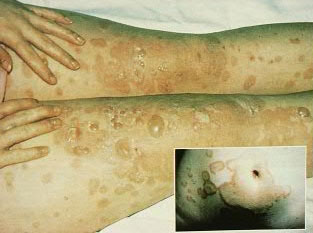This is much rarer, in about 1:50000 pregnancies. The time of onset is variable but earlier than Polymorphic Eruption, from as early as nine weeks or it may occur after the delivery. It can occur in any pregnancies but 50% is in the first pregnancy.
Signs
The appearance may look like Polymorphic Eruption with variable shapes rash, but usually large tense thick-walled blisters quickly develop. The immediate surrounding of the umbilicus is, in contrast, characteristically involved. Commonly affected areas are the abdomen, upper legs, breasts, palms and soles.

The diagnosis is made by examination of a skin sample under microscope, with a special technique called Immunofluorescence.
It frequently worsens after the delivery and can last for a few months. It also tends to recur again in later pregnancies with even more severe rash. In those persisting cases, oral contraception should be avoided as this may make it worse.
Treatments
Treatment usually requires oral steroid over a long period, sometimes even high doses. There is concern over what happens to the babies. Some reports show a higher chance of babies dying before being delivered, or having a lower birth weight, or being premature. Occasionally mild transient blisters may occur in 2% of the babies. In most cases the outcome is satisfactory.

